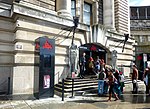Namco Funscape

Namco Funscape, formally known as Namco Funscape County Hall, was a Namco amusement arcade located on the ground to basement levels of County Hall, Westminster, London. Originally opened as Namco Station in August 1997, it operated as one of the capital's leading family and corporate entertainment centres for 25 years, closing permanently in August 2021 due to redevelopment plans blocking a lease renewal.The centre was owned and ran by Namco UK Ltd (formerly Namco Operations Europe), a wholly-owned subsidiary of Bandai Namco Holdings. It has served as one of the company's longest-running flagship locations, outlasting examples opened in other countries. The centre had different types of arcade games and amusement attractions, including arcade video games, electro-mechanical games, redemption games, pool tables, ten-pin bowling, air hockey, Super Shot and Whac-A-Mole. Though generally targeted more towards families and tourist groups, it has also been a site of numerous official and unofficial esports tournaments for arcade video games as well as location tests. Namco continue to operate other centres under the same Funscape name in other parts of the United Kingdom, with similar examples to the former County Hall site situated in Trafford Centre, Manchester, and Metrocentre, Gateshead, as well as other smaller locations elsewhere.
Excerpt from the Wikipedia article Namco Funscape (License: CC BY-SA 3.0, Authors, Images).Namco Funscape
Westminster Bridge Road, London Lambeth (London Borough of Lambeth)
Geographical coordinates (GPS) Address Phone number Website Nearby Places Show on map
Geographical coordinates (GPS)
| Latitude | Longitude |
|---|---|
| N 51.502 ° | E -0.119 ° |
Address
Zen China
Westminster Bridge Road
SE1 7PB London, Lambeth (London Borough of Lambeth)
England, United Kingdom
Open on Google Maps








